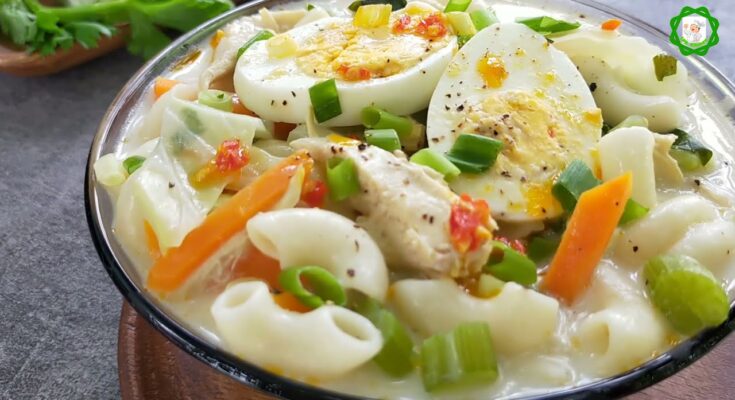Sopas Recipe: Sopas is a creamy and comforting Filipino macaroni soup that’s beloved across generations. It’s not just a dish—it’s an experience, often associated with childhood, rainy days, or special family gatherings. Traditionally made with elbow macaroni, vegetables, chicken (or hotdogs), and evaporated milk, it’s the Filipino version of chicken noodle soup but with a delicious twist.
This soup is a go-to comfort food in the Philippines, especially during cold weather or when someone is under the weather. The warm broth and creamy texture provide an immediate sense of relief, making sopas more than just food—it’s soul food. Whether you’re craving a light yet satisfying meal or trying to whip up something hearty from your pantry staples, sopas is a winner.
Origins and Cultural Significance
Sopas traces its roots to American influence during the colonial period when macaroni soup was introduced. Filipinos adapted the dish by incorporating local flavors, particularly the addition of evaporated milk, making the soup richer and more comforting. Over time, it evolved from a Western-style soup to a staple of Filipino households.
It’s often served at birthday parties, wakes, or community gatherings, embodying the Filipino spirit of sharing. Because it’s budget-friendly and scalable for large groups, sopas holds a cherished place in both urban kitchens and rural homes. It’s more than a dish; it’s a symbol of Filipino hospitality and homegrown ingenuity.
Essential Ingredients for Sopas
Main Components
Here’s a rundown of the basic ingredients you’ll need to make a traditional pot of sopas:
- Elbow macaroni – The backbone of the soup.
- Chicken breast or thigh – Adds flavor and protein; shredded after boiling.
- Evaporated milk – For that signature creamy texture.
- Hotdogs (optional) – A kid-friendly add-in.
- Carrots and cabbage – For color, nutrition, and crunch.
- Garlic and onion – For a flavorful base.
- Butter or oil – Used for sautéing.
- Salt and pepper – For seasoning.
- Water or chicken broth – The liquid base of your soup.
These ingredients are not only accessible but also versatile. The beauty of sopas lies in its adaptability—substitute chicken for leftover turkey, add a splash of cream for extra indulgence, or toss in cheese for a thicker finish.
Optional Add-ins and Variations
Sopas is one of those recipes where you can get creative:
- Corn kernels – For added sweetness and texture.
- Bell peppers – To enhance flavor and color.
- Celery – Classic in Western chicken soups, it adds a fresh note.
- Shredded cheese – For a gooey, indulgent twist.
- Hard-boiled eggs – Sliced and added as garnish.
- Spices like paprika or chili flakes – To give it a mild kick.
Each family often has its own version. Some go all out with rich broths and full meats, while others keep it minimal yet flavorful. You get to decide your sopas signature.
Kitchen Tools You’ll Need
Basic Utensils and Cookware
You don’t need fancy gadgets to make sopas—just a few basic kitchen tools:
- Large pot – To boil the pasta and cook the soup.
- Knife and chopping board – For prepping your vegetables and meat.
- Ladle – For serving up generous portions.
- Colander – To drain the pasta.
- Tongs or fork – For shredding the chicken.
- Measuring cups and spoons – To get the ratios just right.
That’s it—simple tools for a hearty result. Even beginners in the kitchen can confidently whip up this dish with just these basics.
Preparing the Ingredients
Chopping Vegetables and Meat
Start by prepping everything before turning on the heat—this makes the cooking process smoother. Dice the carrots into small cubes, shred the cabbage finely, and slice the hotdogs if using. Boil the chicken in water with a bit of salt until fully cooked, then shred it using two forks. Set aside the broth; you’ll use this as the soup base.
If you’re using garlic and onion (which you absolutely should), mince the garlic finely and chop the onions into small pieces. These ingredients are going to be your flavor anchors, and prepping them well ensures their aroma spreads beautifully through the soup.
Cooking the Pasta
Cook your elbow macaroni according to the package instructions, but undercook it slightly (al dente). It will continue cooking in the soup, and this trick prevents it from turning mushy. Once cooked, drain and set aside. Lightly toss it in a bit of oil to prevent sticking if you’re not adding it to the soup immediately.
Step-by-Step Cooking Instructions
Sautéing Aromatics
Heat butter or oil in a large pot. Once hot, toss in the garlic and sauté until golden and fragrant. Then add the onions, cooking until they’re translucent. This sets the aromatic foundation for your sopas and enhances the overall flavor. You can also toss in a bay leaf at this stage for a subtle earthy aroma.
Adding Meat and Vegetables
Once your aromatics are ready, it’s time to introduce the protein. Add the shredded chicken to the pot and sauté for about 2-3 minutes. If you’re using sliced hotdogs, toss them in at this point too. Let everything brown slightly—this deepens the flavor of your sopas.
Next, add in your chopped carrots and stir well. Give the carrots a head start since they take longer to soften. After 2-3 minutes, pour in the chicken broth or the water you used to boil the chicken earlier. Let it simmer for about 10 minutes, allowing all the flavors to meld beautifully.
Now, it’s time to add the cabbage. You don’t want to overcook it; 2-3 minutes is plenty to keep that fresh crunch. The soup is now a symphony of textures and colors, and you’ll already notice the cozy aroma that sopas is known for.
Incorporating Pasta and Milk
Here comes the magic step. Gently add the cooked macaroni to your pot, stirring carefully so it doesn’t break apart. Let it soak in the flavors for 5 minutes. Then, slowly pour in the evaporated milk while stirring continuously. You’ll see the broth turn creamy and irresistible.
If you prefer your sopas extra creamy, you can add more milk or even a spoonful of all-purpose cream. Taste and adjust seasoning with salt and pepper. Let it simmer for another 3-5 minutes, just enough to heat everything through without boiling the milk too aggressively.
At this point, your sopas is almost done—and the kitchen smells like home. The consistency should be creamy but not overly thick, with all components evenly distributed.
Final Touches and Serving Suggestions
Garnishing and Flavor Enhancements
Right before serving, you can sprinkle some freshly ground black pepper or even a little grated cheese on top. A handful of chopped parsley adds a pop of color and a slight herbal note that cuts through the creaminess.
If you’re feeling indulgent, a few drops of truffle oil or a dash of paprika can elevate your sopas to gourmet levels. For kids, a spoonful of cheddar or quick-melt cheese can make it extra gooey and fun to eat.
Serve hot, ideally with pandesal (Filipino bread rolls) or toast on the side. This combo turns your sopas into a full, satisfying meal perfect for breakfast, lunch, or a late-night snack.
Nutritional Value of Sopas
Health Benefits and Considerations
Sopas isn’t just comforting; it’s also nutritious when prepared right. The chicken provides lean protein, the vegetables add fiber, vitamins, and antioxidants, while the milk supplies calcium and essential fats. Depending on the ingredients used, one serving of sopas can offer a balanced mix of macronutrients.
Here’s a rough breakdown per serving (1.5 cups):
| Nutrient | Amount |
|---|---|
| Calories | ~300-400 |
| Protein | 15-20g |
| Carbohydrates | 30-40g |
| Fat | 10-15g |
| Fiber | 3-5g |
To make it healthier:
- Use low-fat or plant-based milk alternatives.
- Add more vegetables like spinach, peas, or celery.
- Reduce the amount of hotdogs or replace with tofu or mushrooms.
Remember, moderation is key. Sopas can be a nourishing meal or a heavy indulgence depending on how it’s made.
Tips for the Perfect Sopas
Common Mistakes to Avoid
Even though sopas is a straightforward recipe, a few slip-ups can mess with its perfect balance:
- Overcooking the pasta – Always cook it al dente before adding it to the soup.
- Boiling the milk – It can curdle or change the texture, so always simmer gently.
- Skipping the aromatics – Garlic and onion are essential for depth of flavor.
- Adding all the vegetables at once – Layer your cooking to keep textures distinct.
- Using too much broth – Aim for a creamy consistency, not watery.
Want creamier soup? Add less broth. Want more bite? Add fresh herbs or spicy chili oil. The possibilities are endless once you master the basics.
Storing and Reheating Sopas
Shelf Life and Storage Methods
Sopas is best eaten fresh, but it stores surprisingly well if handled right. Store leftovers in an airtight container in the fridge for up to 3 days. Reheat gently on the stovetop over low heat, adding a splash of milk or water to loosen the consistency.
Avoid microwaving directly in the container—transfer to a bowl to prevent overheating. If you plan to store sopas for longer, freeze it before adding the milk, then add the dairy fresh when reheating. This prevents separation and maintains that creamy consistency.
Remember, cooked pasta continues to absorb liquid, so don’t be surprised if your leftover sopas looks thicker the next day. Just adjust with a little broth or milk while reheating.
FAQs about Sopas Recipe
Can I make sopas without meat?
Yes! You can substitute chicken with tofu, mushrooms, or extra vegetables for a delicious vegetarian version.
What type of milk is best for sopas?
Evaporated milk is traditional, but fresh milk, cream, or even plant-based options like soy or almond milk work well.
How long can I store leftover sopas?
Store in the fridge for up to 3 days. Reheat gently with added milk or broth.
Can I freeze sopas for later?
Yes, but freeze it without the milk and add it fresh when reheating to maintain texture.
What other pasta can I use if elbow macaroni isn’t available?
Small shells, ditalini, or even broken spaghetti pieces are great alternatives.
Conclusion
Sopas is more than just a soup—it’s a Filipino classic that combines comfort, flavor, and nutrition in one bowl. With just a few simple ingredients and easy-to-follow steps, you can create a dish that brings warmth and joy to any table. Whether you’re making it for a sick loved one, serving it at a party, or just craving something hearty, sopas will never let you down.
Experiment, adjust, and most importantly—enjoy every spoonful.



